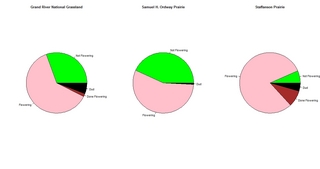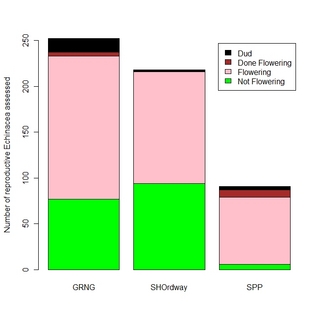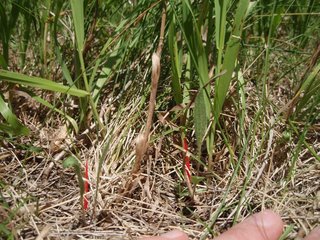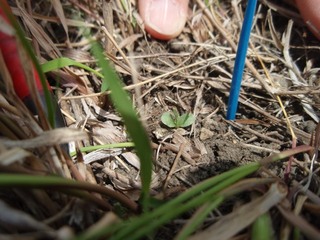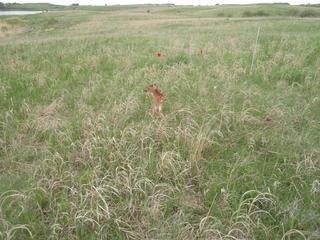|
|
Last week I assessed Echinacea flowering phenology at Grand River National Grassland south of Lemmon, SD, Samuel H. Ordway Prairie west of Leola, SD and Staffanson Prairie near Kensington, MN. Here are a couple of figures I generated to compare phenology at the 3 sites.
First, I made pie charts to show the relative proportions of flowering plants.

Next, to show more quantitative information, I used a stacked bar graph.

These figures illustrate that the flowering phenology is most advanced at Staffanson and least advanced at S. H. Ordway Prairie. Nevertheless, I am encouraged that there are lots of flowering plants at all 3 sites, suggesting that a long-distance cross involving plants from these 3 locations would be possible. I am considering tackling that project next summer, to assess whether there would be lower seedling recruitment from between-population crosses compared to within-population crosses at these 3 sites.
Here’s a picture of some flowering Echinacea at Perch Lake, which is near the S. H. Ordway prairie.

Here is a picture of 2 of the 3 surviving plants in my experimental plot at Perch Lake Waterfowl Production Area, southwest of Leola, SD.
 Each of the 2 Echinacea seedlings is marked with a red party toothpick. We (Shelby, Janelle and I) found them in May when we censused my 2 SoDak plots. We found a total of 10 new seedlings at the Perch Lake site, all of which had 2 cotyledons but no true leaves. I returned to Perch Lake last Thursday, July 8. Sadly, 7 of the seedlings were gone, but I was able to verify that the 3 survivors are, indeed, Echinacea angustifolia. Each of the 2 Echinacea seedlings is marked with a red party toothpick. We (Shelby, Janelle and I) found them in May when we censused my 2 SoDak plots. We found a total of 10 new seedlings at the Perch Lake site, all of which had 2 cotyledons but no true leaves. I returned to Perch Lake last Thursday, July 8. Sadly, 7 of the seedlings were gone, but I was able to verify that the 3 survivors are, indeed, Echinacea angustifolia.
The Perch Lake site is 1 of 3 experimental plots I (and my assistants) sowed in November 2008, to ask whether Echinacea from western South Dakota, central South Dakota and Minnesota exhibit local adaptation in seedling recruitment. More background and results from the 1st 2009 census are displayed in a poster that you can find in the September 2009 archives of the FLOG.
Unfortunately, the Perch Lake site was sprayed with a combination of herbicides (Tordon and Telar) in August 2009. The treatment was lethal to ALL the Echinacea seedlings that emerged in 2009. Thus, the 3 surviving seedlings from this year are the only living Echinacea in this plot! Fortunately, I was able to census the plot shortly after it was sprayed, and I am confident that I found the survivors up to that point.
I plan to present a talk about my local adaptation experiment at the North American Prairie conference in August.
Today Josh and I searched the last two circles at Staffanson Prairie (SPP). Our last search centered on this focal plant:

We found 23 seedlings in the circles at SPP, bringing our grand total for this year to 74. In comparison, we found 29 seedlings in 2006, 135 in 2007, 239 in 2008, and 93 in 2009. That’s quite a lot of year-to-year variation!
Here’s a document that outlines a proposed visor form for the census of Caroline’s Next Generation Rescue experiment.
Proposed protocol for Next Gen Rescue census 2010.docx
Yesterday, Janelle G. and Shelby F. helped me do the May census on the Hegg Lake plot of my local adaptation experiment. There were some surprises, including 3 or 4 NEW seedlings!

Another surprise was a visit from this fawn.

Another interesting discovery was a cluster of egg sacs. Anybody know what critter would leave these?

Today and tomorrow we plan to census the two South Dakota plots that are part of this experiment.

With the early spring we’ve been having in Minnesota, I was curious about whether the Echinacea plants were sprouting. My husband and I made a day-trip out to Douglas County last Saturday (May 1). I did a quick check of my crossing experiment plot at Hegg Lake. I found some of the toothpicks we used to mark seedlings last summer, along with some of the plants–which are now a year old. I plan to do a complete census in another couple of weeks.

We also stopped by the common garden. Here’s one of the plants–already quite a bit of growth on the first of May.
Here’s a poster I presented at the Evolution 2009 symposium at the University of Nebraska-Kearney, September 2-4, 2009. The poster describes my local adaptation experiment, and results of the early summer seedling searches at my three experimental sites.
DykstraPosterEvolution2009UNK.pptx
Here is a draft version of a protocol for seedling re-finds in the prairie remnants. Please read and critique. Protocol for seedling refinds 2009.docx
Today I found some healthy-looking Echinacea seedlings at my experimental plot in Perch Lake WPA near Leola, SD.
 View image View image
The DNR sprayed this area (including my plot) last week, in an effort to eradicate yellow toadflax. It seems that my seedlings were shielded by the tall grass. It’s also likely that the seedlings are not in a rapidly growing stage, so they may have been less vulnerable than other broad-leaf plants.
Here’s another picture:

Apparently there is some question about what I have been doing lately. Daniel was partly right–data entry has been on my list. Remember checking the recruitment zones earlier this summer? And being rewarded with all those six packs? Well, there were some ambiguities in the data. I compiled a list 2009 zones to check.xls of all the things we need to check in the recruitment zones. Some of these (checking burn status) can be taken care of with a visit to the plot; other ambiguities may be cleared up by taking some tissue samples and sending them to Chicago for microsatellite analysis.
|
|
